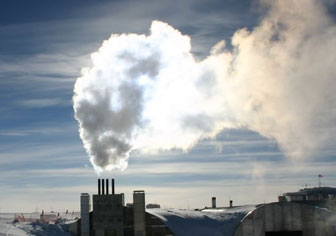Wall Street looks at energy efficiency to boost profits
Wall Street looks at energy efficiency to boost profits
mongabay.com
August 27, 2007
Today the Wall Street Journal featured a special section on energy efficiency. The paper reports that business is increasingly looking at reducing energy use as a way to improve the bottom line.
“Now, with oil, gas and electricity prices soaring, companies are beginning to realize that saving energy can translate into dramatically lower costs. And that means higher profits and happier shareholders — not to mention a cleaner planet,” write Leila Abboud and John Biers. “So, companies are beginning to pour more money into making old equipment energy-efficient or upgrading to cleaner models. And they’re starting to streamline their operations to cut down on waste.”
“Even companies with longstanding energy-saving programs are redoubling their efforts in light of rising fuel costs and greater pressure from the public to address global warming.”
Abboud and Biers cite a recent International Energy Agency study that found energy use in heavy industry could be reduced by 18% to 26% by applying available technologies, a savings is equivalent to one to one-and-a-half times Japan’s annual energy consumption. Light industries like retailing could cut energy use by up to 50 percent.

Image courtesy of the Lawrence Berkeley National Laboratory. |
The authors point to several examples:
- STMicroelectronics, Europe’s biggest semiconductor maker, has saved a net $1 billion from 1994 through 2006 through improved energy efficiency at its factories. The projects cost about $300 million.
- Wal-Mart will meet a target to reduce energy use by 20% in existing stores by 2012
- Heineken will use 15% less energy in 2010 than it did in 2002
Abboud and Biers say that until now, companies rarely looked at energy-savings. Most efficiency projects are approved because they offer some other benefit, like improved performance or worker safety.
“Companies are leaving a lot of opportunities on the table,” Mark Brownstein, the managing director of business projects for the climate and air program at Environmental Defense, told Christine Buurma in a second article.
“Businesses are kind of like the rest of the country in that they have traditionally underestimated what energy costs are,” added David Hamilton, global warming and energy director for the Sierra Club.
The Energy Report is available to subscribers at wsj.com
Related articles
Improving energy efficiency will require overcoming market distortions
(5/20/2007) In a new study, McKinsey&Company, one the world’s most respected management consulting firms, reports that the world should be able to cut energy demand growth by half over the next 15 years without compromising economic growth. However it says that market forces along will not drive the transition–targeted policies will be needed to overcome present market failures and policy distortions.
Measures to drive adoption of super efficient cars in the U.S.
(4/11/2007) To reduce its growing dependence on foreign oil the United States could implement relatively low-cost measures to put millions of super efficient vehicles on American highways, said energy efficiency expert Amory Lovins of the Rocky Mountain Institute in a speech at Stanford University. The measures could significantly cut oil usage, help fight climate change, and make U.S. roads safer.
U.S. can cut oil imports to zero by 2040, use to zero by 2050
(3/29/2007) The United States could dramatically cut oil usage over the next 20-30 years at low to no net cost, said Amory B. Lovins, cofounder and CEO of the Colorado-based Rocky Mountain Institute, speaking at Stanford University Wednesday night for a week-long evening series of lectures sponsored by Mineral Acquisition Partners, Inc.
Energy efficiency helped California grow an extra $31 billion finds study
(12/4/2005) Countering Bush administration claims to the contrary, environmental officials for the state of California and the Brazilian state of Sao Paulo have found significant evidence that greenhouse gas pollution can be substantially reduced at a profit rather than a cost. The study, commissioned by the William and Flora Hewlett Foundation, found that energy efficiency has helped the California economy grow an extra 3 percent – a $31 billion gain – compared to business as usual. Further, the researchers say that each Californian typically saved about $1,000 per year between 1975 and 1995 just through efficiency standards for buildings and appliances.